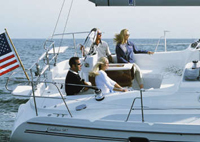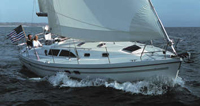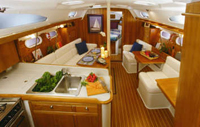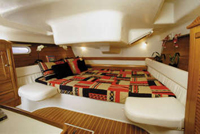Catalina 387 Review – Modern Boating (June 2004)
Issue: June 2004
Manufacturer: Catalina
 You can leave it to the Europeans to try dramatic new ideas on production yachts. Americans have a different approach – they tend to ref ne their craft, working on the principle that if it ain’t broke, don’t fix it. Americans don’t guess at what the market wants; they give the market that it asks for. A logical approach and an obvious one, you may say, but it is an approach the rest of the World’s consumer economies have never understood fully.
You can leave it to the Europeans to try dramatic new ideas on production yachts. Americans have a different approach – they tend to ref ne their craft, working on the principle that if it ain’t broke, don’t fix it. Americans don’t guess at what the market wants; they give the market that it asks for. A logical approach and an obvious one, you may say, but it is an approach the rest of the World’s consumer economies have never understood fully.
 Tom Clynes, from Catalina’s Victorian dealer Pier 35 and Catalina importer Norm Ambrose impress upon me that this Catalina 387 has been developed as a result of owner feedback. This could be dismissed as good salesmanship on their part, but if you take the guided tour of the 387 you can see for yourself the level of detail refinement. Tom bought the 387 shown here to use as his own boat. Why the 387? I ask. “The average afternoon sea breeze on Port Phillip is 20-25 knots”, says Tom, ”and I wanted a boat I would be comfortable sailing offshore and on the bay. “Port Phillip is shallow with a long fetch and you get 1.5-2m seas quite close together. This is a deep-bilge boat so you get a reasonably comfortable ride without a lot of slamming”. Tom is American-born – here we have an American marketing an American boat – but he is also the owner. You can learn a lot about a boat by watching how the owner handles it.
Tom Clynes, from Catalina’s Victorian dealer Pier 35 and Catalina importer Norm Ambrose impress upon me that this Catalina 387 has been developed as a result of owner feedback. This could be dismissed as good salesmanship on their part, but if you take the guided tour of the 387 you can see for yourself the level of detail refinement. Tom bought the 387 shown here to use as his own boat. Why the 387? I ask. “The average afternoon sea breeze on Port Phillip is 20-25 knots”, says Tom, ”and I wanted a boat I would be comfortable sailing offshore and on the bay. “Port Phillip is shallow with a long fetch and you get 1.5-2m seas quite close together. This is a deep-bilge boat so you get a reasonably comfortable ride without a lot of slamming”. Tom is American-born – here we have an American marketing an American boat – but he is also the owner. You can learn a lot about a boat by watching how the owner handles it.
The 387 is heavyish at 8618kg (19,000lb) with the fin keel (which draws 2.18m), or 8845kg for the fin keeler drawing 1.47m. Tom chose the wing keel version, because he plans to do some ”gunkholing” (American for poking around shallow waterways) so at the bottom of this 387’s keel is Catalina’s delta-shaped _ n, which has a wingspan of about a metre. The wing-keeler has extra ballast to compensate for any loss in righting moment. The 387’s overall length is 12.14m (39ft 10in), but hull length is 11.81m or 38ft 9in. The just-under 40ft mark is a good size for a yacht – big enough to tackle almost anything, small enough to handle by yourself.
 All 387s have a two-cabin layout, and in the saloon two seating areas convert to beds, so you can sleep a total of seven. You can choose between a transverse or centreline berth in the master cabin aft, a huge cabin, which spans the boat’s full width. So there is a decent-sized cabin in the bow, a big galley, a good saloon and a big bathroom aft, en suite with the master cabin but with a door in the saloon which provides day-head access. The hull is hand-laid fibreglass, the deck a composite of glass, foam and balsa. The tapered alloy mast is stepped on deck, but is supported below decks by a king (compression) post. The rigging is a surprise – there is a babystay (short inner forestay) to help steady the mast at sea and add a little bend control; there are single lower (aft) shrouds; and the diagonals (the stays that run diagonally between the spreaders) are continuous, led to the deck so they can be adjusted without going up the mast, a feature usually found on racing boats. The single backstay is not quickly adjustable.
All 387s have a two-cabin layout, and in the saloon two seating areas convert to beds, so you can sleep a total of seven. You can choose between a transverse or centreline berth in the master cabin aft, a huge cabin, which spans the boat’s full width. So there is a decent-sized cabin in the bow, a big galley, a good saloon and a big bathroom aft, en suite with the master cabin but with a door in the saloon which provides day-head access. The hull is hand-laid fibreglass, the deck a composite of glass, foam and balsa. The tapered alloy mast is stepped on deck, but is supported below decks by a king (compression) post. The rigging is a surprise – there is a babystay (short inner forestay) to help steady the mast at sea and add a little bend control; there are single lower (aft) shrouds; and the diagonals (the stays that run diagonally between the spreaders) are continuous, led to the deck so they can be adjusted without going up the mast, a feature usually found on racing boats. The single backstay is not quickly adjustable.
 The bow fitting has a double anchor roller and the chain locker can be divided down the centreline to handle two rodes. You can shackle the active rode to a deadeye to take the load off the electric windlass, which has toepad controls set beneath the locker hatch. The Schaeffer headsail furler is all stainless steel and alloy – no plastic. The vang is a stainless strut with a spring providing support for the boom. All halyards and controls are led to the aft end of the coachroof via ball-bearing blocks. The genoa tracks are long; Tom reckons he should be able to run an MPS using the existing blocks and primary winches (Harken No.48s). In the transom are two lockers; Tom uses the starboard one for man-overboard gear; the portside one opens into the deep cockpit locker. There is a matching locker to starboard; both are full-depth i.e. chest height if you climb in. Tom has added a dodger made locally by Saint Marine Trimming of Sandringham and it’s a beauty. It is cut high to maximise headroom when going below, headroom which is affected (when the dodger is up) by the height of the substantial transverse bridgedeck at the front of the cockpit which stiffens the hull structure, keeps water out of the saloon and provides headroom in the stern cabin below. The dodger has big clear panels, which give perfect visibility from the helm.
The bow fitting has a double anchor roller and the chain locker can be divided down the centreline to handle two rodes. You can shackle the active rode to a deadeye to take the load off the electric windlass, which has toepad controls set beneath the locker hatch. The Schaeffer headsail furler is all stainless steel and alloy – no plastic. The vang is a stainless strut with a spring providing support for the boom. All halyards and controls are led to the aft end of the coachroof via ball-bearing blocks. The genoa tracks are long; Tom reckons he should be able to run an MPS using the existing blocks and primary winches (Harken No.48s). In the transom are two lockers; Tom uses the starboard one for man-overboard gear; the portside one opens into the deep cockpit locker. There is a matching locker to starboard; both are full-depth i.e. chest height if you climb in. Tom has added a dodger made locally by Saint Marine Trimming of Sandringham and it’s a beauty. It is cut high to maximise headroom when going below, headroom which is affected (when the dodger is up) by the height of the substantial transverse bridgedeck at the front of the cockpit which stiffens the hull structure, keeps water out of the saloon and provides headroom in the stern cabin below. The dodger has big clear panels, which give perfect visibility from the helm.
Both sleeping cabins have hanging lockers and plenty of storage. The bow cabin has a good berth, cutaway slightly on one side for ease of access. Tom chose the transverse berth in the aft cabin because it has full sitting headroom, and plenty of space. The optional longitudinal berth arrangement may have limited headroom, but without seeing one I cannot swear to that. On this boat you can sit up in bed and read; reading lights are provided either side.
This is a big, big cabin, a stateroom, with plenty of stowage of all types. There is more than 6ft of headroom near the door and stooping headroom across the boat’s width. The saloon has an L-shaped settee to port around the dinette table. The tabletop is removable (it stows securely in the aft cabin) replaced by a smaller top for general use. On the starboard side is what Tom calls a games table between two single lounges. Sit on the aft lounge, face aft and there is the navigation table. Both these tables lower to provide berths.
When seated at the dinette you can see through windows in the hull sides. Several small hatches in the roof diffuse the light in the saloon, and the brightness below is enhanced by the trim, which is teak but it is not stained, so the effect is of a light timber. The galley has excellent sinks and features the trademark Catalina fridge/freezer which is both front- and top-opening so you don’t have to dive into the fridge to rescue the jar of gherkins which has found its way to the bottom. The stove is a gimballed three burner and stove unit.
The bathroom is big, with a separate shower area screened by a bi-fold glass door. The holding tank is accessible behind a door in the bathroom wall. The head is electric-powered. The Catalina’s deep bilge provides room for a lot of stuff under the floor. The bilge is 18 inches deep and narrow so bilge water would have trouble slopping out. The fl oat switch is higher than the automatic bilge pump to cut down cycling with small volumes of water. Batteries, too, are under the floor. All the underfloor engineering seems to be well installed and clearly marked. The inverter on this boat, installed locally, is underfloor.
The companionway steps structure is a once-piece moulding, which swings forward to reveal the front half of the motor. On the other side of the main bulkhead, in the master cabin, is a moulded vanity unit, which also swings to reveal the back half of the unit, plus the shaft. The engine has its own sump, not connected to the main bilge, to catch dripped oil. Catalina’s standard sails are a fully battened main and a 135 per cent furling genoa whose foot is cut to the height of the lifelines for visibility and to avoid dragging it across stanchions and lifelines.
Catalina’s use the Dutchman furling system, – ne vertical lines which lead through eyelets in the sail and are held aloft by a line which parallel’s the sail’s leech. Tom’s mainsail is quite new and he reckons it hasn’t learned yet to fold itself properly, but even so the main drops in a fairly orderly fashion onto the boom and looks after itself there, while the skipper gets on with more urgent tanks. Tom chose not to order the optional electric winch as he wanted the physical exercise of hoisting the main. Under power the 40hp three-cylinder Yanmar gave us 5.3 knots over the ground at a very easy 2000rpm; 2500 is noisier and good for 6.5 knots. The breeze was from dead ahead. We had 7 knots of southerly; the gust of the day, and there was only one, was about 10. In a quiet Port Phillip seaway we could pinch the Catalina up towards a 30-degree wind angle but she was de- nitely happier at 35-40 degrees. At that angle we had a top speed of 5.5 knots over the ground in 9 knots of True breeze. Freed off onto a reach the same breeze gave us 6.3 knots of boat speed, good speed for a boat wearing a – xed three-blade prop (the latter is an option; a two-blader is standard).
The 387 is easy to handle. The traveler control lines have enough power for easy adjustment under load without resorting to the winch. The mainsheet is not clutched; instead it is in a clamcleat on the coachroof. Tom runs the tail back towards the wheel, where the helmsman can flick it free of the cleat if needed, then re-cleat by pulling through the clam. You can also use the Harken No.32 winch; two are mounted on the coachroof to handle all the control lines. What characteristics are attributable to the wing keel? Hard to judge; you would have to try the fin-keeler side by side, but as Tom points out this is a cruiser, not a cruiser/racer. The fin-keeler might buy the last few degrees of pointing ability, but that is not important when cruising. At no other time can you tell that this boat has an unusual keel. Unless it is in the way it handles. Most boats have one feature they do better than all others and the 387’s standout skill is maneuverability. Going forward under power it spins instantly on its axis, turning in its own length. In reverse it tracks straight, allowing for slight prop walk to port.
Entering and leaving a marina berth is easy, and the boat is just as handy under sail. The price, too, is right. The base boat starts at $275,000. The boat shown here, with the optional interior trim material, dodger, full instrumentation, CD system and TV antenna costs around $295,000. This is a fairly conservative yacht in that styling and configuration are quite traditional, but it is ultra-modern in the sense that the builders are more interested in making the boat effective than following the convention that has dogged yacht design for too long. The modern yacht is comfortable. And increasingly logical.
* Prices & data correct at time of publication
